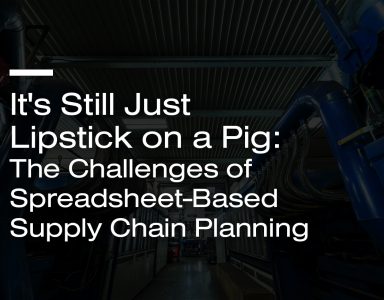
By Olusola Oduntan, Sr. Product Manager.
With unprecedented disruption in today’s supply chains, demand and supply planning are more challenging than ever. Trade wars, tariffs, the pandemic, and a host of other significant events that were once rare or generational in occurrence, are now the new normal.
As these types of disruptions shift supply chain planning into a new normal as well, old models and methodology give way to new strategies and a focus on agility. These new strategies drive the need for a more robust software solution.
Recognizing these challenges require robust additions to their already best in class demand and supply software, Plex DemandCaster Supply Chain Planning has introduced Constrained Capacity Production Leveling as part of their suite of solutions.
What is Constrained Capacity?
Production capacity represents the amount of output a manufacturer can produce within a specified time frame with the available resources. These resources include equipment, labor, and materials. Constrained capacity occurs when the manufacturer lacks resources to meet the existing demand.
Constrained capacity can occur for many different reasons:
- Equipment outages
- Staffing shortages
- Planning oversight
- Space limitations and physical plant locations
- Raw materials and component shortages
- Regulatory restrictions
- Logistic challenges
The Need for Constrained Capacity Production Leveling
While the connection between planning and capacity may seem intuitive, planning systems have failed to tie the two together. To the extent that they were analyzed, they were often reviewed separately, which created a gap that Plex DemandCaster Supply Chain Planning solution wanted to address.
Based on early TPS methodologies, production leveling and smoothing– or in the Japanese model, Heijunka – seeks to reduce unevenness in the production flow and help reduce waste. As supply chains have become more challenging and complex, Plex DemandCaster Supply Chain Planning realized a greater need to improve the quality of created production schedules and by tying capacity to planning.
It’s easier to establish a more secure and predictable supply chain with a smooth and even flow of scheduled production. Unevenness can lead to supply chain instability, and the old method of using a production schedule free of capacity constraint analysis meant that planners may over or undershoot.
What Are the Benefits of Capacity Constrained Production Leveling?
There are several benefits to leveling your production by tying planning to capacity constraints. They include:
- By tying production to capacity, planners don’t schedule more than what they have the capacity for, which helps absorb demand shocks and lowers production instability costs. It also means that companies can apply level loading for production over the planning period. This way, when demand changes suddenly, disruptions can be minimized.
- By integrating inventory planning with constrained capacity planning, companies are able to proactively plan for future changes in demand whilst ensuring they are developing a feasible master production schedule.
- Traditionally, companies looked at production schedules over time and considered capacity a separate issue. But companies want and need to see both. As production is optimized over time, schedules become more precise and achievable, opening the door to more focused planning such as grouping like products.
- As production is optimized, supply chains begin to level and even out, allowing tighter control and improved response to demand spikes and supply chain disruption.
How Does Constrained Capacity Production Leveling Work in Plex DemandCaster Supply Chain Planning Software?
Each manufacturer’s operations are unique, including those in different industries and within the same industry. Needs may also vary based on the size of a company. Plex DemandCaster’s Constrained Capacity Production Leveling can be configured to model the unique scheduling and capacity needs of customers and display how products should be sequenced on a work center. This may include defining how many resources are available for each work center over time.
Planners can run reports to analyze future demand and capacity requirements that can be utilized to set daily, weekly, and monthly capacity utilization targets.
The capacity functionality compliments Plex DemandCaster Supply Chain Planning’s existing software by integrating capacity planning with the master production scheduling process. Users see an advanced planning application that links capacity with new orders, existing order positions, forecasts, incoming demand, and more.
Production Leveling Made Possible
While there may be a learning curve to incorporate the capacity constraint module, that learning curve aims to improve how planners schedule. By applying capacity planning to Plex DemandCaster Supply Chain Planning’s already robust planning solution, the master scheduling process will be more accurate and more agile. It will optimize production and supply chain over time for better performance and greater predictability.
To learn more about Plex DemandCaster’s Constrained Capacity Production Leveling capabilities, contact us today.


